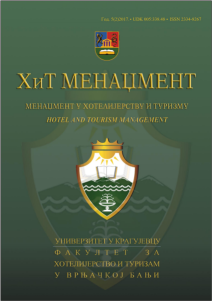Managing destination brand vs. location brand: conceptual and practical challenges
Keywords:
brand, destination, location, identity, tourismAbstract
Destination branding has become an unavoidable topic in both professional literature and practice of the organisations responsible for the tourism promotion.
However, aside from the tourism context, the principles of brand management can be applied to locations (villages, cities, regions, countries) that include a broader range of industries in order to achieve total economic growth of a country. The aim of this paper is to address conceptual similarities and differences in managing destination brand vs. location brand through the review of relevant literature from this area. Likewise, the specifics of the destination brand are presented, as well as a new paradigm in place branding based on place – identity dynamics. The paper combines exploratory research approach with the inductive and deductive reasoning – abductive approach. Furthermore, qualitative research methods, together with a causal approach, have made a better examination of the investigated issues possible.
Downloads
References
American Marketing Association (AMA). (2017). Dictionary. preuzeto 16. oktobra 2017, sa www.ama.org/resources/pages/dictionary.aspx?dLetter=B
Anholt, S. (2004). Nation-brands and the value of provenance, in Morgan, A., Pritchard, A. & Pride, R. (eds) ?Destination Branding — Creating the Unique Destination Proposition‘, 2nd edn, Elsevier, Oxford, UK.
Baker, M. J. & Cameron, E. (2008). Critical success factors in destination marketing. Tourism and Hospitality Research, 8(2), 79–95. doi: 10.1057/thr.2008.9
Balakrishnan, M. S. (2009). Strategic branding of destinations: a framework. European Journal of Marketing, 43(5/6), 611-629. doi: 10.1108/03090560910946954
Buhalis, D. (2000). Marketing the Competitive Destination of the Future, Tourism Management, 21, 97–116. doi: 10.1016/S0261-5177(99)00095-3
Govers, R. & Go, F. (2009). Place Branding - Glocal, Virtual and Physical Identities, Constructed, Imagined and Experienced. UK: Palgrave Macmillan UK
Kavaratzis, M. & Hatch, M. J. (2013). The Dynamics of Place Branding- An Identity-based Approach to Place Branding Theory. Marketing Theory, 13(2), 69-86. doi: 10.1177/1470593112467268
Kalandides, A. (2011). The Problem with Spatial Identity: Revisiting the ?Sense of Place. Journal of Place Management and Development, 4(1), 28–39. doi: 10.1108/17538331111117142
Kapferer, J. (2001). Strategic Brand Management: Creating and Sustaining Brand Equity Long Term, 2nd edn, Kogan Page, Milford, CT.
Kerr, G. (2006). From destination brand to location brand. Brand Management, 13(4/5), 276-283. doi: 10.1057/palgrave.bm.2540271
Mandari?, M. (2016). Strategijski brend menadžment. Vrnja?ka Banja: Fakultet za hotelijerstvo i turizam u Vrnja?koj Banji.
Mandari?, M. i Stamenkovi?, I. (2017). Istraživanje zna?aja manifestacija za razvoj i brendiranje grada Niša kao turisti?ke destinacije. Menadžment u hotelijerstvu i turizmu, 5(1), 64-74.
Melovi?, B. i Mitrovi?, S. (2014). Brendiranje turisti?kih destinacija - marketing pristup i iskustva Crne Gore. III nau?no -stru?na konferencija sa me?unarodnim u?eš?em Jahorinski poslovni dani 2014: „Inovativnost i preduzetništvo u turizmu?, Jahorina, BiH.
Mili?evi?, C. i ?or?evi?, N. (2016). Glavni gradovi kao turisti?ke destinacije. Menadžment u hotelijerstvu i turizmu, 4(1), 21-30.
Montenegro Travel (2017). About Montenegro. preuzeto 16. oktobra 2017, sa https://www.montenegro.travel/.
Morgan, N. & Pritchard, A. (2002). Contextualising Destination Branding in Morgan, N., Pritchard, A. & Pride, R. (eds), (2002) Destination Branding: Creating the unique destination proposition, Butterworth-Heinemann, Oxford.
Morgan, N. & Pritchard, A. (2004). Meeting the Destination Branding Challenge in Morgan, N., Pritchard, A. & Pride, R. (eds), (2004) Destination Branding: Creating the unique destination proposition, 2nd edn, ButterworthHeinemann, Oxford.
McEnally, M., Martha, R. & de Chernatony, L. (1999). The evolving nature of branding: Consumer and managerial considerations. Academy of Marketing Science Review, 2, 1–26.
Petromilli, M., Morrison, D. & Million, M. (2002). Brand architecture: Building brand portfolio value, Strategy and Leadership, 30(5), 22–28. doi: 10.1108/10878570210442524
Pike, S. (2004). Destination Marketing Organisations. Elsevier, Oxford.
Ritchie, R. & Ritchie, J. (2002). A Framework for an Industry Supported Destination Marketing Information System. Tourism Management, 23, 439–454. doi: 10.1016/S0261-5177(02)00007-9
Future Brands (2006). Country Brand Index. preuzeto 10. oktobra 2017, sa www.futurebrand.com/03showcase/leadership/cbi/pdf/cbi_eng06.pdf
Hall, J. (2004). Branding Britain. Journal of Vacation Marketing, 10 (2), 171-185. doi: 10.1177/135676670401000207
Hankinson, G. (2005). Destination brand images: A business tourism perspective. Journal of Services Marketing, 19(1), 24–32. doi: 10.1108/08876040510579361
Hatch, M. & Schultz, M. (2002). The Dynamics of Organisational Identity. Human Relations, 55(8), 989–1018. doi: 10.1177%2F0018726702055008181
Hatch, M. & Schultz, M. (2003). Bringing the corporation into corporate branding. European Journal of Marketing, 37(7/8), 1041–1064. doi: 10.1108/03090560310477654
Downloads
Published
How to Cite
Issue
Section
License
Copyright (c) 2017 Faculty of Hotel Management and Tourism in Vrnja?ka Banja

This work is licensed under a Creative Commons Attribution-NonCommercial-NoDerivatives 4.0 International License.







